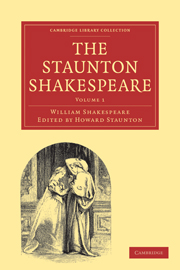Book contents
- Frontmatter
- Contents
- PREFACE
- SOME ACCOUNT OR THE LIFE OF SHAKESPEARE
- SHAKESPEARE'S WILL
- PRELIMINARY MATTER IN THE FOLIO OF 1623
- THE ADDRESS TO THE READER
- COMMENDATORY VERSES
- ADDENDA AND CORRIGENDA
- THE TWO GENTLEMEN OF VERONA
- LOVE'S LABOUR'S LOST
- THE COMEDY OF ERRORS
- ROMEO AND JULIET
- THE TAMING OF THE SHREW
- KING JOHN
- A MIDSUMMER NIGHT'S DREAM
- THE MERCHANT OF VENICE
- KING RICHARD THE SECOND
- THE FIRST PART OF KING HENRY THE FOURTH
- THE SECOND PART OF KING HENRY THE FOURTH
- THE MERRY WIVES OF WINDSOR
- MUCH ADO ABOUT NOTHING
THE TWO GENTLEMEN OF VERONA
Published online by Cambridge University Press: 29 August 2010
- Frontmatter
- Contents
- PREFACE
- SOME ACCOUNT OR THE LIFE OF SHAKESPEARE
- SHAKESPEARE'S WILL
- PRELIMINARY MATTER IN THE FOLIO OF 1623
- THE ADDRESS TO THE READER
- COMMENDATORY VERSES
- ADDENDA AND CORRIGENDA
- THE TWO GENTLEMEN OF VERONA
- LOVE'S LABOUR'S LOST
- THE COMEDY OF ERRORS
- ROMEO AND JULIET
- THE TAMING OF THE SHREW
- KING JOHN
- A MIDSUMMER NIGHT'S DREAM
- THE MERCHANT OF VENICE
- KING RICHARD THE SECOND
- THE FIRST PART OF KING HENRY THE FOURTH
- THE SECOND PART OF KING HENRY THE FOURTH
- THE MERRY WIVES OF WINDSOR
- MUCH ADO ABOUT NOTHING
Summary
This play, indisputably one of the earliest complete productions of Shakespeare's mind, was first printed in the folio of 1623, where, owing to the arbitrary manner in which the dramas are disposed, it is preceded by The Tempest, assuredly one of the poet's latest creations. Some of the incidents in The Two Gentlemen of Verona, Steevens conjectures, were taken from Sidney's Arcadia (Book I. Chapter vi.), where Pyrocles consents to lead the Helots; but the amount of Shakespeare's obligations to this source does not appear to be considerable. For a portion of the plot he was unquestionably indebted to the episode of Felismena, in the Diana of George of Montemayor, a work very popular in Spain towards the end of the seventeenth century, and which exhibits several incidents, and even some expressions, in common with that part of the present play, which treats of the loves of Proteus and Julia. Of this work there were two translations, one by Bartholomew Yong, the other by Thomas Wilson. There is a strong probability, however, that Shakespeare derived his knowledge of Felismena's story from another source, namely: “The History of Felix and Philiomena,” which was played before the Queen at Greenwich in 1584. Be this as it may, the story of Proteus and Julia so closely corresponds with that of Felix and Felismena, that no one who has read the two can doubt his familiarity with that portion of the Spanish romance.
- Type
- Chapter
- Information
- The Staunton Shakespeare , pp. 1 - 46Publisher: Cambridge University PressPrint publication year: 2009First published in: 1858

